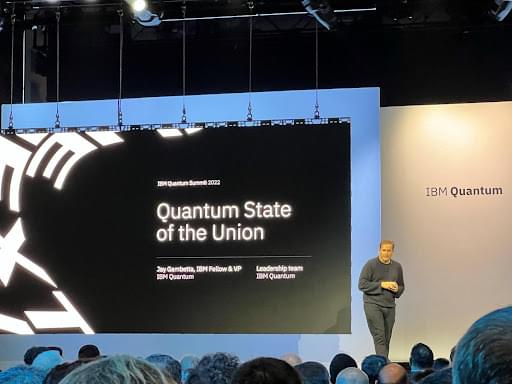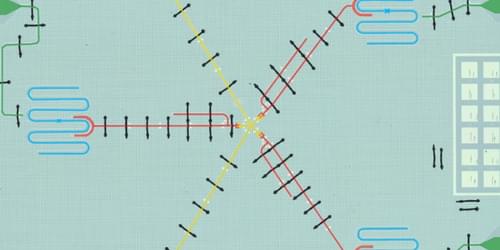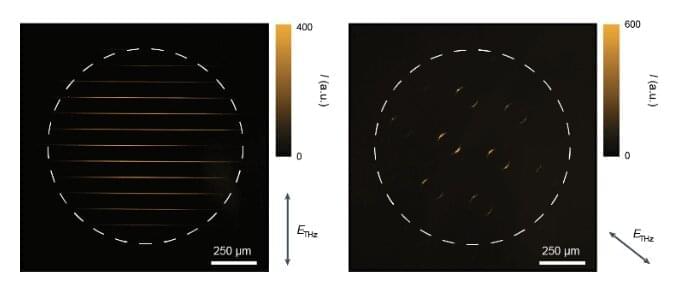With the reveal of its 433 qubit quantum computer, IBM takes a large step forward in the race towards next-generation processing.




Terahertz (THz) radiation is electromagnetic radiation ranging from frequencies of 0.1 THz to 10 THz, with wavelengths between 30μm and 3mm. Reliably detecting this radiation could have numerous valuable applications in security, product inspection, and quality control.
For instance, THz detectors could allow law enforcement agents to uncover potential weapons on humans or in luggage more reliably. It could also be used to monitor natural environments without damaging them or to assess the quality of food, cosmetics and other products.
Recent studies introduced several devices and solutions for detecting terahertz radiation. While a few of them achieved promising results, their performance in terms of sensitivity, speed, bandwidth and operating temperature is often limited. Researchers at Massachusetts Institute of Technology (MIT), University of Minnesota, and other institutes in the United States and South Korea recently developed a new camera that can reliably detect THz radiation at room temperature, while also characterizing its so-called polarization states. This camera, introduced in a paper published in Nature Nanotechnology, is based on widely available complementary metal-oxide-semiconductors (CMOS), enhanced using quantum dots (i.e., nm-sized semiconductor particles with advantageous optoelectronic properties).


The experiment could help to form a unified theory of quantum gravity.
Scientists have, for the first time ever, made light appear to move simultaneously forward and backward in time. The new method, achieved by an international group of scientists, could help create novel quantum computing techniques and give scientists a better understanding of quantum gravity, a report from LiveScience.
It was achieved thanks to a combination of two principles that form a part of the bizarre world of quantum mechanics.
What is a “quantum time flip”?
NeoLeo/iStock.
The new method, achieved by an international group of scientists, could help create novel quantum computing techniques and give scientists a better understanding of quantum gravity, a report from LiveScience reveals.

This research could potentially lead to a better understanding of the galaxy and its many mysteries.
It’s a cosmic riddle: How can galaxies remain together when all the matter we observe isn’t enough to keep them intact? Scientists believe an invisible force must beat play, something so mysterious they named it “dark matter” because of its lack of visibility.
This mysterious presence accounts for nearly three times more than what we can observe — a startling 27% of all existence! The mysterious dark matter is a profound mystery to scientists, its existence making up nearly one-third of the universe’s energy and mass yet remaining elusive due to its ability to avoid detection.
IStock / agsandrew.
This mysterious presence accounts for nearly three times more than what we can observe – a startling 27% of all existence! The mysterious dark matter is a profound mystery to scientists, its existence making up nearly one-third of the universe’s energy and mass yet remaining elusive due to its ability to avoid detection. Dark matter particles move relatively slowly, which explains why it has been mostly concealed from view until now.

There are serious indications from attempts to create a quantum theory of gravity that time must disappear completely from the description of the quantum universe. This has been known since 1967, when DeWitt discovered the Wheeler-DeWitt equation. I shall argue that this forces us to conceive explanation and causality in an entirely new way. The present can no longer be understood as the consequence of the past. Instead, I shall suggest that one may have to distinguish possible presents on the basis of their intrinsic structure, not on the basis of an assumed temporal ordering. If correct, this could have far-reaching implications. Hitherto, because the present has always been interpreted as the lawful consequence of the past, science has made no attempt to answer ‘Why’ questions, only ‘How’ questions. But if there is no past in the traditional sense, we must consider things differently. Thus, if we eliminate time, we may even be able to start asking “Why” questions.
Specification of a point and tangent vector in conformal superspace (CS) determines a slab of spacetime in CMC foliation and unique curve in CS.
Almost perfect implementation of Mach’s principle because local inertial frames, local proper distance and local proper time all emergent and determined by the universe’s shape and shape velocity.
The Mystery: Shape velocity, as opposed to shape direction, is last vestige of Newton’s absolute space and time. Responsible for expansion of the universe and perhaps perfect transformation theory in quantum theory of the universe.
This lecture was delivered on the 16th Kraków Methodological Conference “The Causal Universe”, May 17–18, 2012.
More information:
http://causal-universe.philosophyinscience.com.
http://copernicuscenter.edu.pl.
Photos:
http://www.adamwalanus.pl/2012/cc120517.html

After recombining the superposed photons by sending them through another crystal, the team measured the photon polarization across a number of repeated experiments. They found a quantum interference pattern, a pattern of light and dark stripes that could exist only if the photon had been split and was moving in both time directions.
“The superposition of processes we realized is more akin to an object spinning clockwise and counter-clockwise at the same time,” Strömberg said. The researchers created their time-flipped photon out of intellectual curiosity, but follow-up experiments showed that time flips can be paired with reversible logic gates to enable simultaneous computation in either direction, thus opening the way for quantum processors with greatly enhanced processing power.
Theoretical possibilities also sprout from the work. A future theory of quantum gravity, which would unite general relativity and quantum mechanics, should include particles of mixed time orientations like the one in this experiment, and could enable the researchers to peer into some of the universe’s most mysterious phenomena.

The concept of ‘anti-realism’ is widely seen as a fact of life for many physicists studying the mysterious effects of quantum mechanics. However, it also seems to contradict the assumptions of many other fields of research. In his research, Dr William Sulis at McMaster University in Canada explores the issue from a new perspective, by using a novel mathematical toolset named the ‘process algebra model’. In suggesting that reality itself is generated by interacting processes more fundamental than quantum particles, his theories could improve researchers’ understanding of fundamental processes in a wide variety of fields.
The concept of ‘locality’ states that objects and processes can only be influenced by other objects and processes in their immediate surroundings. It is a fundamental aspect of many fields of research and underpins all of the most complex systems we observe in nature, including living organisms. “Biologists and psychologists have known for centuries that the physical world is dominated by processes which are characterized by factors including transformation, interdependence, and information”, Dr Sulis explains. “Organisms are born, develop, continually exchange physical components and information with their environment, and eventually die.”
Beyond biology, the principle of locality also extends to Einstein’s theory of special relativity. Since the speed of light sets a fundamental speed limit on all processes in the universe, the theory states that no process can occur if it has not been triggered by another event in its past, at a close enough distance for light to travel between them within the time separating them. In general, these theories are unified by a concept which physicists call ‘realism’. Yet despite this seemingly intuitive rule, physicists have increasingly come to accept the idea that it doesn’t present a full description of how all processes unfold.